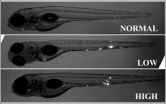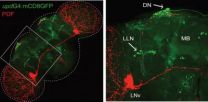(Press-News.org) A gene that influences the inflammatory response to infection may also predict the effectiveness of drug treatment for a deadly form of tuberculosis.
An international collaboration between researchers at the University of Washington in Seattle, Duke University, Harvard University, the Oxford University Clinical Research Unit in Vietnam and Kings College London reported these findings Feb. 3 in the journal Cell.
These results suggest the possibility of tailoring tuberculosis treatment, based on a patient's genetic sequence at a gene called LTA4H, which controls the balance between pro-inflammatory and anti-inflammatory substances produced during an infection.
Tuberculosis can take hold if disease-fighting inflammation is either too weak or too strong. The strength of the response is in part the result of a person's LTA4H gene sequence. Knowing whether a patient has the gene sequence for one extreme response or the other could help guide medication decisions.
Lalita Ramakrishnan, professor of microbiology, medicine and immunology at the University of Washington and the senior author of the study, said that the study suggested that that increased TB disease severity in humans can occur for fundamentally opposite reasons. "The ability to tailor therapies to these divergent inflammatory states, based on a patient's sequence at LTA4H, could improve patient outcomes."
This important observation for people began with a study of the tiny zebrafish. In these animals, the researchers linked mutations in the zebrafish version of the LTA4H gene to increased susceptibility to a TB-like infection. David Tobin, now on the faculty of the Department of Molecular Genetics and Microbiology at Duke University, is first author of the study. He performed the research while he was a postdoctoral fellow in the University of Washington laboratory of Dr. Ramakrishnan, working closely with another postdoctoral fellow Francisco Roca.
After they understood the biological basis of susceptibility to infection in the zebrafish, the researchers turned to the same gene in humans. They identified a sequence of the gene that led to higher activity and increased inflammation. They then collaborated with other researchers at the University of Washington, including Mary-Claire King, and researchers in Vietnam and the U.K., including Guy Thwaites, to study the gene among patients in Vietnam with TB. They discovered that patients carrying one copy of the high-activity sequence of the gene and one copy of the low-activity sequence were relatively protected from TB meningitis, a particularly deadly form of TB. Surprisingly, people with two copies of the high-activity sequence of the gene fared just as poorly as people with two copies of the low-activity sequence. This "heterozygous advantage," or "Goldilocks effect," is an unusual finding in human genetics.
King commented "Throughout human history, people with both forms of the LTA4H gene have probably been more likely to survive when exposed to TB than people with only one form of the LTA4H gene. This advantage may have led to both forms of the gene persisting in human populations. Selection by infectious diseases has had an enormous impact on the evolution of our species."
This surprising finding, the researchers noted, implicated both insufficient and overly abundant inflammation as different ways TB could take hold in the body. By analyzing clinical data from patients in Vietnam with a particularly severe form of TB called TB meningitis, the researchers found that anti-inflammatory therapy only benefited patients with the gene sequence that corresponds to excess inflammation. The patients with the insufficient inflammation gene sequence derived no benefit from what has been adopted as a standard therapy for TB meningitis.
Given the clinical and therapeutic implications of these findings, the researchers sought the underlying molecular mechanisms for both extremes. For this they turned back to the zebrafish.
In collaboration with Charles Serhan, of Harvard University they showed that one gene variant weakened inflammation through the overproduction of substances called lipoxins. Hyperinflammation results from a gene variant that leads to an excess of leukotriene B4. Either can interfere with the overall levels of tumor necrosis factor, a substance that, when present in normal amounts, protects against TB infection and other diseases.
Paradoxically, either a deficiency or an overkill of tumor necrosis factor can cause macrophages, the host cells that gobble up pathogens, to die by bursting and releasing the TB pathogens into a "permissive extracellular milieu where they can grow exuberantly into corded mats" the researchers said.
The researchers then discovered that corticosteroids, which are in wide clinical use, as well the active ingredient in aspirin decreased TB infection in zebrafish with the "hot responder" genotype, but increased TB infection in their "cold responder" genotype siblings.
The researchers concluded, "If patients succumb to TB for two fundamentally different reasons, then it is imperative to design therapeutic strategies that reflect this dichotomy. For example, if evaluating the treatment effects of dexamethasone on TB meningitis doesn't take into account host genotype, the very substantial benefits of the drug for the high-reactive genotype may be diluted by its neutral or possibly detrimental effects on individuals with the low-activity genotype."
A simple gene test for the high-responding variant, they said, could provide a rapid, inexpensive way to determine which patients would benefit from dexamethasone therapy added to standard infection-fighting drugs. They also believe clinical studies are urgently needed to be sure patients with the low-reactive genotype are not harmed by unnecessary dexamethasone treatment, and to find alternative treatment strategies for this group, such as agents that limit lipoxin production or boost inflammation.
Because the basic inflammatory biochemical pathways affected by the LTA4H gene are common to many infections, the researchers said TB treatment strategies suggested by their findings may hold promise for other serious infections.
INFORMATION:
The study was funded by grants from the National Institutes of Health, an American Cancer Society postdoctoral fellowship, a Mallinckrodt Scholar Award, a postdoctoral fellowship from the educational ministry of Spain, the Northwest Regional Center of Excellence for Biodefense and Emerging Infectious Diseases, the Burroughs Wellcome Fund, the Wellcome Trust, the American Skin Association, the Dermatology Foundation, and the Chinese Academy of Sciences.
Ramakrishnan is a recipient of the NIH Director's Pioneer Award, Tobin is a recipient of the NIH Director's New Innovator Award and King is an American Cancer Society Professor.
Others on the project team are Sungwhan F. Oh, Ross McFarland, Thad D. Vickery, John P. Ray, Dennis C. Ko, Yuxia Zou, Nguyen D. Bang, Tran T. H. Chau, Jay C. Vary, Thomas R. Hawn, Sarah J. Dunstan, and Jeremy J. Farrar.
Treatment for tuberculosis can be guided by patients' genetics
Gene that influences inflammatory response to infection predicts effectiveness of drug therapy
2012-02-08
ELSE PRESS RELEASES FROM THIS DATE:
Study: Breastfeeding can be tougher for women when pregnancy is unplanned
2012-02-08
Women who did not plan to get pregnant are much more likely to stop breastfeeding within three months of giving birth, according to a study published in the journal Current Anthropology. The research suggests that women whose pregnancies were unplanned often experience more emotional and physical discomfort with breastfeeding compared to women who planned to get pregnant.
More than 40 percent of the women in the study, which focused on mothers from low-income neighborhoods in São Paulo, Brazil, had stopped exclusively breastfeeding by three months, despite the fact that ...
Drinking large amounts of soft drinks associated with asthma and COPD
2012-02-08
A new study published in the journal Respirology reveals that a high level of soft drink consumption is associated with asthma and/or chronic obstructive pulmonary disease (COPD).
Led by Zumin Shi, MD, PhD, of the University of Adelaide, researchers conducted computer assisted telephone interviewing among 16,907 participants aged 16 years and older in South Australia between March 2008 and June 2010 inquiring about soft drink consumption. Soft drinks comprised Coke, lemonade, flavored mineral water, Powerade, and Gatorade etc.
Results showed that one in ten adults drink ...
Scripps research and technion scientists develop biological computer to encrypt and decipher images
2012-02-08
LA JOLLA, CA -- Scientists at The Scripps Research Institute in California and the Technion–Israel Institute of Technology have developed a "biological computer" made entirely from biomolecules that is capable of deciphering images encrypted on DNA chips. Although DNA has been used for encryption in the past, this is the first experimental demonstration of a molecular cryptosystem of images based on DNA computing.
The study was published in a recent online-before-print edition of the journal Angewandte Chemie.
Instead of using traditional computer hardware, a group ...
Largest Health and Wellness Company Expands Offerings and Announces Company Name Change to Wilkins Solutions
2012-02-08
The nation's largest health, fitness, recreation, and amenities distributor has changed its name from Wilkins Fitness Enterprises to Wilkins Solutions Enterprises. No longer just selling commercial fitness equipment such as treadmills, ellipticals, and strength equipment, Wilkins' offerings now include playground equipment, flooring, rehab equipment, patio furniture, and ADA compliant pool lifts in addition to their previous lines. To reflect its wider diversity of offerings, the holding company has formally announced a change in its name.
The name change comes on the ...
Fall of Communism changed mathematics in US: New study
2012-02-08
The collapse of the Soviet Union in 1992 brought an influx of Soviet mathematicians to U.S. institutions, and those scholars' differing areas of specialization have changed the way math is studied and taught in this country, according to new research by University of Notre Dame Economist Kirk Doran and a colleague from Harvard.
Titled "The Collapse of the Soviet Union and the Productivity of American Mathematicians," the study will appear in an upcoming edition of the Quarterly Journal of Economics.
"In this paper, we examine the impact of the ...
Justifying insurance coverage for orphan drugs
2012-02-08
How can insurers justify spending hundreds of thousands of dollars per patient per year on "orphan drugs" – extremely expensive medications for rare conditions that are mostly chronic and life-threatening -- when this money could provide greater overall health benefit if spread out among many other patients? Those spending decisions reflect the "rule of rescue," the value that our society places on saving lives in immediate danger at any expense. But the broad application of the rule of rescue will be increasingly difficult to support as "personalized medicine" produces ...
Post surgical phone support improves outcome following knee replacement
2012-02-08
SAN FRANCISCO -- Poor emotional health and morbid obesity are associated with less functional gain following total knee replacement (TKR) surgery. In the new study, "Can Telephone Support During Post-TKR Rehabilitation Improve Post-op Function: A Randomized Controlled Trial," presented today at the 2012 Annual Meeting of the American Academy of Orthopaedic Surgeons (AAOS), approximately 180 patients were categorized by gender, body mass index (BMI) and emotional health. Each patient randomly received either emotional telephone support by a trained behavioral specialist, ...
Molecular path from internal clock to cells controlling rest and activity
2012-02-08
PHILADELPHIA – The molecular pathway that carries time-of-day signals from the body's internal clock to ultimately guide daily behavior is like a black box, says Amita Sehgal, PhD, the John Herr Musser Professor of Neuroscience and Co-Director, Comprehensive Neuroscience Center, at the Perelman School of Medicine, University of Pennsylvania.
Now, new research from the Sehgal lab is taking a peek inside, describing a molecular pathway and its inner parts that connect the well-known clock neurons to cells governing rhythms of rest and activity in fruit flies. Sehgal is ...
How early breast tumors become deadly: A small group of molecules might hold the answer
2012-02-08
Some early-stage breast cancers are potentially harmless, but others invade surrounding healthy tissue and become deadly.
This study has identified a small pattern of molecules that highlights important differences between early-stage breast tumors and invasive, deadly ones.
The findings might lead to a way to identify early tumors that will likely become invasive.
COLUMBUS, Ohio – Researchers have discovered a restricted pattern of molecules that differentiate early-stage breast tumors from invasive, life-threatening cancer. They also found a similar molecular signature ...
NASA satellite sees tropical storm Cyril a strong, compact storm
2012-02-08
Tropical Storm Cyril was known as "11P" has been strengthening since February 6, and still appears very compact on infrared NASA satellite data.
In the morning hours of February 7 (local time Vanuatu) Cyril was located south of the island of Vavau in the Kingdom of Tonga. All warnings for Niue and Tonga have now been cancelled.
During the morning hours of February 7, Cyril picked up speed and is moving to the southeast at 28 knots (~32 mph/~52 kph). Cyril's maximum sustained winds were near 45 knots (~52 mph/~83 kph). Those tropical-storm-force winds only extended out ...
LAST 30 PRESS RELEASES:
New fully digital design paves the way for scalable probabilistic computing
Membrane electrode assembly design for high-efficiency anion exchange membrane water electrolysis
U.S. debt ceiling disputes show measurable impact on global crude oil markets
Climate extremes triggered rare coral disease and mass mortality on the Great Barrier Reef
Direct observation reveals “two-in-one” roles of plasma turbulence
Humans rank between meerkats and beavers in monogamy ‘league table’
US fossil reveals early mass-burial event and ancient microbial attack
Sedative choice could improve outcomes for breathing tube patients
New superconducting thin film for quantum computer chips
Simulations reveal protein "dynamin" constricts cell membranes by loosening its grip
Nearly 1 in 5 UK emergency department patients cared for in corridors/waiting rooms
Heavy energy drink intake may pose serious stroke risk, doctors warn
Violence against women and children among top health threats: New global study reveals disease burden far larger than previously estimated
Predicting who is at risk of developing type 1 diabetes, as new drugs now available
New gene-mapping method unlocks hidden drivers of cancer
Ocean current and seabed shape influence warm water circulation under ice shelves
Call to increase funding for ‘invisible’ Deaf victim-survivors of domestic abuse
University of Maryland School of Medicine names distinguished scientist and academic leader Gerald M. Wilson, PhD, as Chair of the Department of Biochemistry and Molecular Biology
Receptors in mammary glands make livestock and humans inviting hosts for avian flu
Icy hot plasmas
Treating adults with autism: Maryland Clinical Center offers national blueprint for care after pediatric transition
University of Phoenix College of Doctoral Studies releases white paper on reclaiming control to build workforce resilience
NCCN Summit seeks to improve care for veterans and first responders with cancer from line-of-duty exposure
ERC Consolidator Grant for soft robotics researcher
Dual-action arts and wellbeing program transforms dementia care
The global plastic waste trade contributes to coastal litter in importing countries, study shows
UT Dallas partners with Tech Mahindra on AI innovation
Blinking less could signal the brain is working harder to listen, Concordia study shows
Male bonobos track females’ reproductive cycle to maximize mating success
New report outlines science priorities for human Mars exploration
[Press-News.org] Treatment for tuberculosis can be guided by patients' geneticsGene that influences inflammatory response to infection predicts effectiveness of drug therapy



